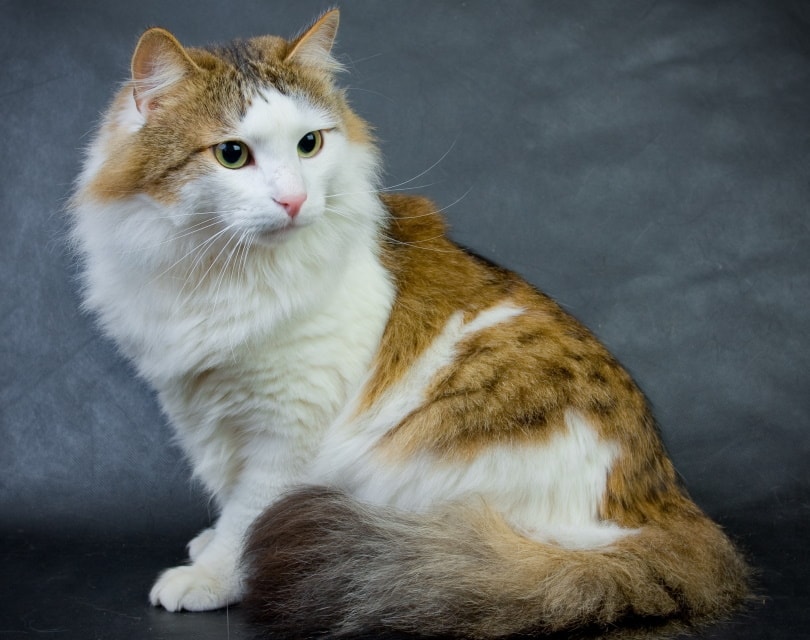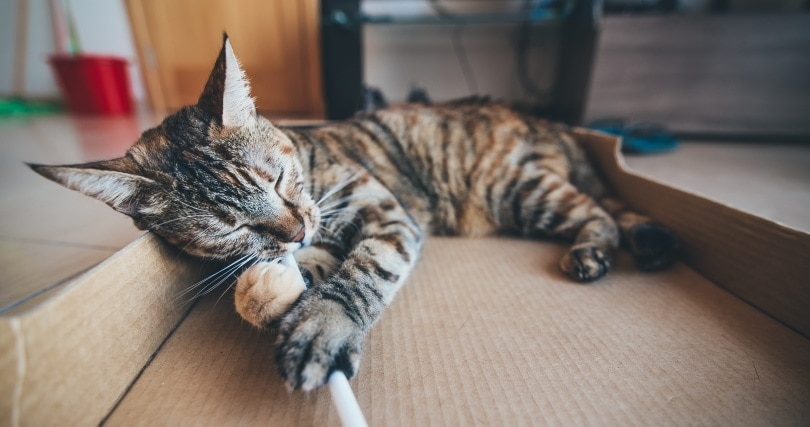9 DIY Cat Harnesses You Can Make Today (With Pictures)
Updated on
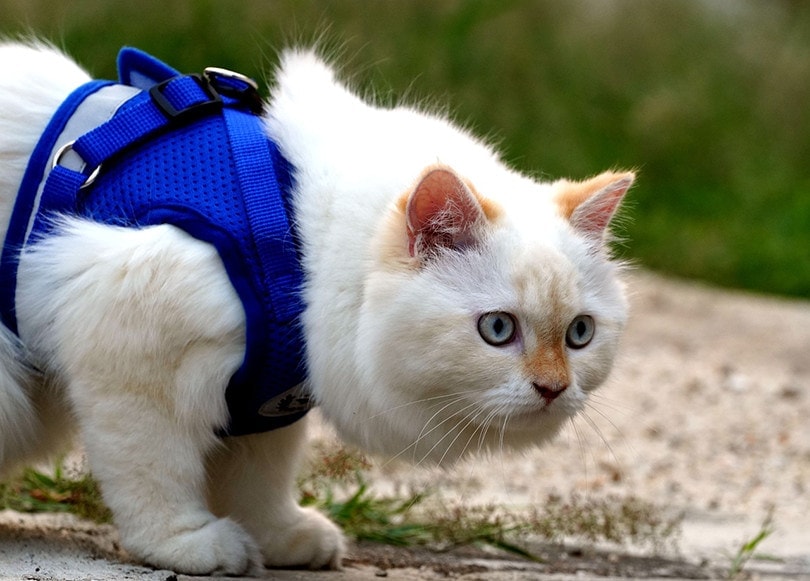
Putting your cat in a harness can be a fun way for them to explore the outdoors safely. However, it can be challenging to get your cat used to a harness, or they may never take to it at all.
Cat harnesses can be expensive, occasionally ill-fitted, and sometimes they’re a little boring to look at. Fortunately, there are plenty of DIY cat harness plans if you’re looking for a more cost-effective, fun, and unique option. Here’s a list of some projects that you can try out today.
The 9 DIY Cat Harnesses
1. DIY Nylon Cat Harness by Family Handyman

| Materials: | ¾-inch buckle, ¾-inch nylon webbing, ¾-inch tri-glide slide, lobster clasp, D-ring |
| Tools: | Scissors, sewing machine, tape measure, lighter |
| Difficulty: | Easy |
This DIY cat harness has a straightforward design that you can complete in a short amount of time. Since it just uses cuts of nylon webbing, there’s minimal sewing. It’s also adjustable so that it can grow with a young kitten, and you don’t have to spend too much time getting exact measurements.
The harness has two sets of buckles. One set clips around the neck, and the other clips around the waist. The D-ring attaches to the waistband of the harness, so if your cat pulls, you don’t have to worry about accidental asphyxiation.
Overall, this harness is quick and easy to assemble, and it has a secure design so that your cat can roam around outside safely.
2. DIY Cat Harness With Velcro Straps by Animal Wellness Magazine

| Materials: | D-ring, ¾-inch Velcro strips, 1½-inch Velcro strips, fabric |
| Tools: | Scissors, sewing machine, tape measure |
| Difficulty: | Intermediate |
This project provides instructions for a nice Velcro-oriented harness for cats. You can select any style of fabric, but it’s recommended to use breathable fabric that doesn’t contain too much elastic. If a fabric is too stretchy, your cat can slip out of it, especially over time.
The design also provides an ample amount of support all around the cat’s body, so your cat won’t strain their neck if they pull or run around while wearing the harness. You can also add small personal touches, such as buttons, bows, and bells, to the strap that holds the D-ring.
3. DIY Denim Cat Harness by Koala Sewing
| Materials: | Denim, D-ring, buckles, tri-glide slide |
| Tools: | Sewing machine, scissors, tape measure, iron |
| Difficulty: | Moderate |
If you have a pair of old jeans lying around, you can transform it into a denim cat harness. This project has simple instructions. All you have to do is cut strips of denim that match the width of your buckles and tri-glide slide.
However, it can take time to complete the harness because you have to iron down each strip to make it stay flat. You also have to stitch along the entire length of the denim strips.
You can make a matching leash by attaching a denim strip to a lobster clasp. Once you complete this project, you and your cat can dress in matching denim gear every time you go outside for a walk.
4. DIY Crocheted Cat Harness by Craft Bits

| Materials: | Worsted weight acrylic yarn, keyring |
| Tools: | H crochet hook, tape measure |
| Difficulty: | Easy |
This cat harness is a relatively easy pattern that beginner crochet artists can make. The main stitches that it uses are half-double crochet stitches and slip stitches. All you have to do is make sure to take down accurate measurements.
It’s best to have your cat try on the harness as you make it to ensure that the size is right. You can slightly adjust the size of the harness as you stitch by making loose or tight stitches. Once you complete the base of the harness, you can add an outer lining with a different color to add more fun and variety to the harness.
Keep in mind that this harness is best for cats that don’t tend to pounce or pull. Before using it outside, test out the harness in an enclosed area to ensure that your cat doesn’t slip out of it.
5. Simple DIY Rope Harness by Adil Nusair
| Materials: | Cat collar, elastic rope |
| Tools: | Hairclip |
| Difficulty: | Easy |
If your cat has never used a harness and you don’t want to spend too much money on materials or expensive harnesses, try out this quick DIY project. All you need is a cat collar and elastic rope.
This harness isn’t meant for extended use, but it’s a great makeshift option that you can use to get your cat used to wearing one. It’s thin and lightweight, so your cat won’t mind it as much as thicker harnesses made of nylon strips or fabric.
Since the harness is very thin, we don’t recommend it for outside use. Once your cat gets accustomed to it, you can transition to having your cat wear a thicker harness that’s more suitable for outdoor use.
6. DIY Cat Harness With Buttons by CATGAMES
| Materials: | Fabric, buttons, D-ring |
| Tools: | Sewing machine, scissors, tape measure |
| Difficulty: | Easy |
A harness using buttons is an easy alternative to using Velcro if you’re concerned about the Velcro scratching your cat. This simple harness has a comfortable fabric body that you can fasten with buttons. However, you have to be particularly precise with your measurements because this harness isn’t adjustable.
Along with providing instructions for making the harness, the tutorial also includes steps for making adorable cloud wings that you can attach to the top of the harness. Therefore, it’s great as a costume, and you can also use it to walk your cat outside.
7. DIY Reflective Cat Harness by So Sew Lovely
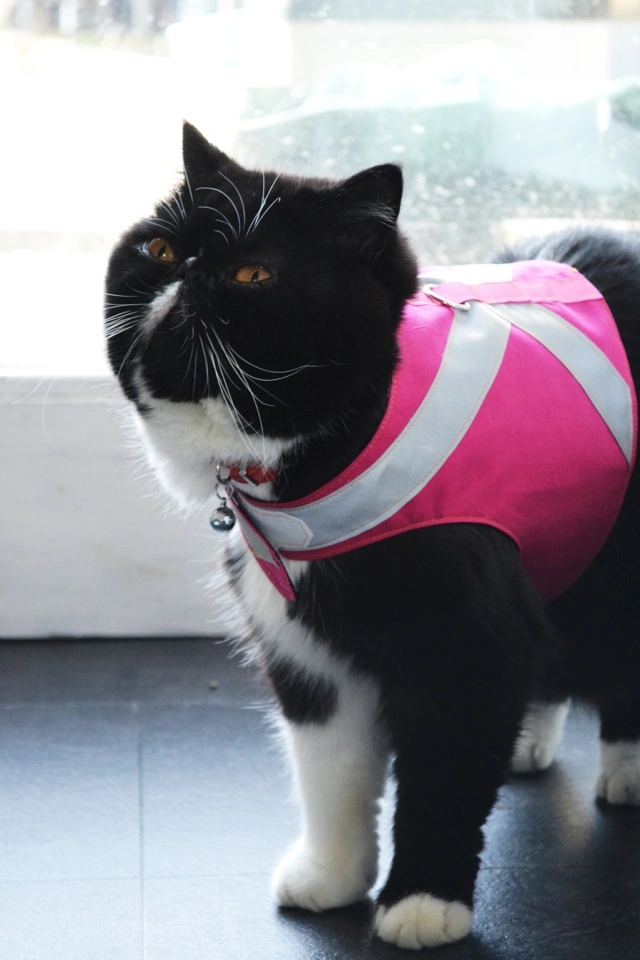
| Materials: | Reflective tape, fabric, Velcro, D-ring |
| Tools: | Sewing machine, scissors |
| Difficulty: | Moderate |
Cat owners concerned about nighttime safety can add reflective tape to a cat’s harness. This harness also uses two layers of fabric so that you can use different fun patterns for the inner and outer layers. It’s also very comfortable for your cat to wear, and you can put it on your cat for daily use.
As an added convenience, the tutorial includes a pattern template that you can use to help you draw out measurements for your cat. Once you complete this harness, you’ll be ready to take your cat outside for a walk at any time of the day or night.
8. DIY Cat Harness and Leash Set by Mikinoos
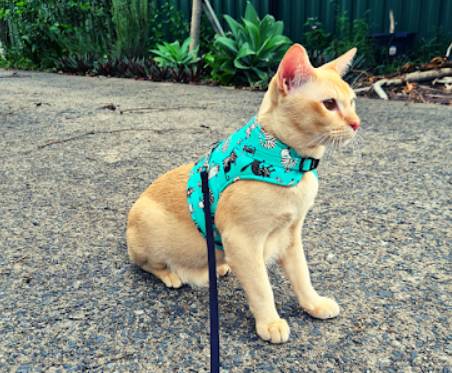
| Materials: | Cotton fabric, batting, buckle straps, 10mm buckle clip, 10mm tri-glide adjustable buckle, D-ring, Snap hook, Velcro strips |
| Tools: | Sewing machine, sewing pins, measuring tape, iron |
| Difficulty: | Moderate |
Cat owners looking for a personalized touch will like this cat harness. It’s a wide vest pattern, and you can display any type of fun or cute fabric that matches your cat’s look and personality. If you’re feeling extra fancy, you can use a different kind of fabric for the inner layer.
The harness has an inner and outer layer with batting in between, so it’s very comfortable for your cat. The waistband is adjustable with Velcro, and you don’t have to worry too much about getting perfect measurements.
This DIY project comes with a basic pattern for the body of the harness, and you can also follow a video tutorial to complete it.
9. DIY Decorated Cat Harness by Glogirly

| Materials: | Dog harness, decorations (beads, rhinestones, woolen flowers) |
| Tools: | Needle and thread, seam ripper, hot glue gun (optional) |
| Difficulty: | Easy |
If you’re simply looking to decorate your cat’s harness, this tutorial provides inspiration for creating a unique harness that’ll stand out from the rest. All you need is an x-small or small dog harness that fits your cat and decorative materials, such as beads, rhinestones, and woolen flowers.
The tutorial also gives instructions on how to remove harness logos without damaging the harness. It recommends using a needle and thread to sew on the decorations so that the pieces stay on securely. However, if you don’t have time to sew, you can always use a hot glue gun. Just keep in mind that using a hot glue gun may cause the pieces to fall out faster, depending on your cat’s activity level.
How To Train Your Cat To Wear a Harness
Training a cat to get used to a harness usually takes some time and patience. The key is to do harness training in short, stress-free intervals and to break down the process into manageable steps for your cat.
Normalize the Harness
Before attempting to put the harness on your cat, it’s essential to get them used to the harness. Start gently placing it near your cat, and give them a treat every time the harness appears. Place the harness near your cat’s food bowl during meal times. The goal is to associate the harness with a delicious reward.
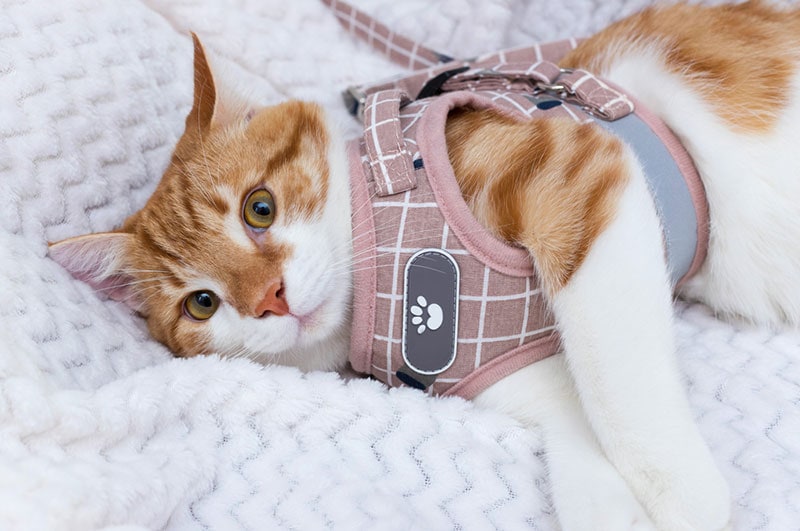
Investigate the Harness
Once your cat is used to seeing the harness, encourage them to touch the cat harness. Hold the harness in your hand and a treat in your other hand. You can hold the harness close to the treat and allow your cat to eat the treat each time they come near the harness.
Start closing the gap and only give treats if any part of your cat’s body touches the harness. Do this repeatedly until your cat is comfortable with having the harness touch their body.
If the harness requires your cat to insert their head through it, loosen the harness so that it’s at its largest size. Then, start holding treats behind the loop of the harness. Encourage your cat to peek their head through the loop, and give them a treat every time they’re successful.
For step-in harnesses, wrap the harness around your cat’s body without buckling it. Reward your cat with a treat every time they let you attach the harness.
Put on the Harness
Once your cat’s completely comfortable with the harness, you can secure the buckles. Once you buckle the harness, immediately unbuckle it and give your cat a treat. Keep doing this and increase the amount of time the harness stays buckled in small increments. Eventually, your cat will become comfortable wearing the harness for longer periods of time.
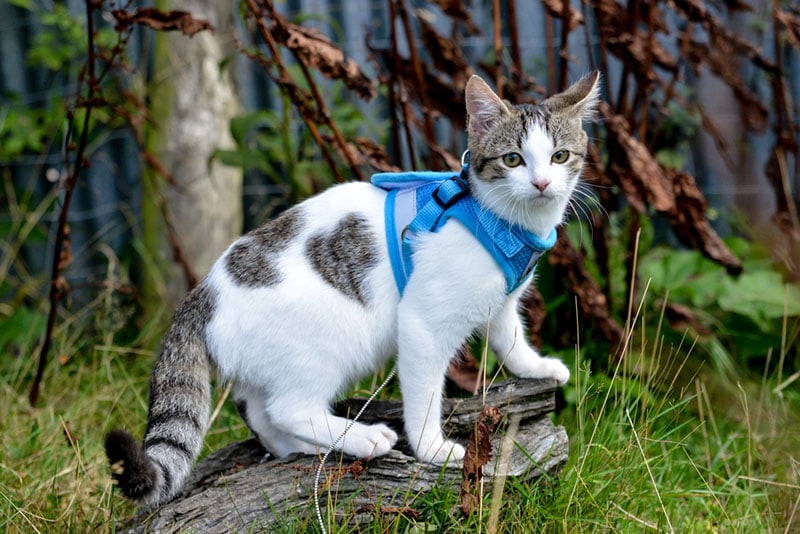
Conclusion
While the idea of creating a unique harness that will make your cat stand out sounds quite appealing, remember that your cat’s safety and comfort must come first. Always test the harness out inside before you take your cat for their first walk, and consider your cat’s temperament. If there’s a chance that your cat will do a great deal of pulling, you must ensure that the harness will stay on.
But if all goes well, any one of these harnesses will make a statement, and you can show off your cat in pride when you go for your daily walk or slow stroll.
Related Reads:
- DIY Cat Couch Protector Plans You Can Build Today
- DIY Cat Onesie Plans You Can Make Today (with Pictures)
Featured Image Credit: ignartonosbg, Pixabay


